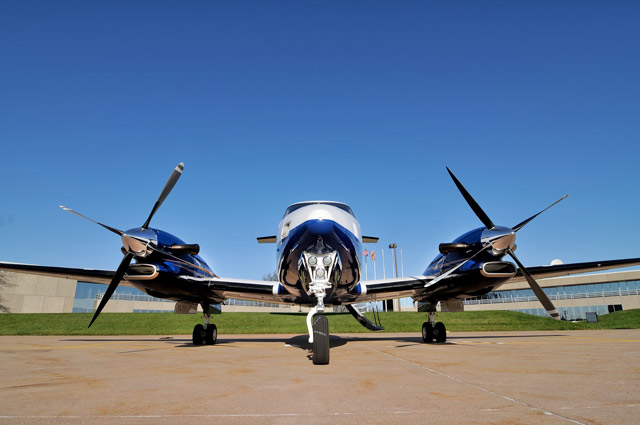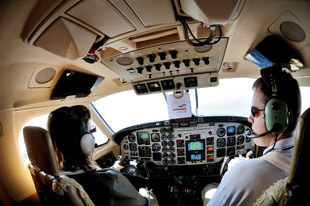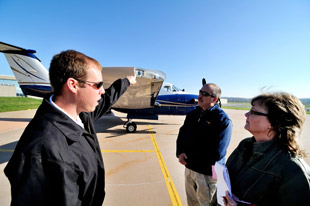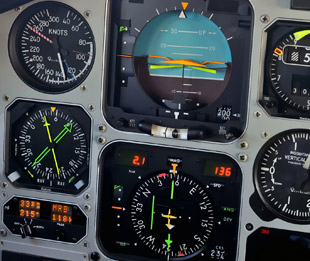
If you want to fly a King Air 300 or 350 like the one profiled in the February 2015 issue (“Turbine Pilot: The Ultimate King Air”), you will need a type rating, because these models are certified under FAA’s Part 23 Commuter category. Well-known training institutions can guide you through the intricacies of turboprop flying using a detailed syllabus and extremely sophisticated flight training devices. It is an exhaustive process, requiring hours of classroom time learning the airplane systems and emergency procedures, sandwiched with intensive simulator sessions—in which you not only learn how to fly the airplane, but also the many ways in which you can wind up in an emergency.
But what if you could get your training with a mixture of simulator time and some action in an actual left seat? You can. Potomac Flight Training in Sterling, Virginia, will put you in the left seat of its King Air 300.
In addition to initial and recurrent training, Potomac Flight Training offers high-altitude endorsements, pre-hire instrument currency evaluations, and crew training for civilian clients, plus a roster of services for government clients, such as DHC–7 initial mission training.
Potomac Flight Training also provides a wide variety of training opportunities for the rotary-wing pilot, conducted with an full-motion AATD certified as a twin turbine modeled after the Eurocopter EC135. The company can provide EC135 familiarization as well as “white-out”/“brown-out” or inadvertent IMC training. Arthur, a retired Army pilot, flew Chinooks, Blackhawks, and “all of the museum helicopters.”
The company recently led a crew of National Transportation Safety Board accident investigators through a combination of simulator and actual helicopter training sessions to help them experience inadvertent white-outs, brown-outs, engine failures, and autorotations.AOPA
Email [email protected]
First-time turbine
A piston pilot tries out a King Air 300
When you’re accustomed to preflighting a Piper Cherokee 140, doing the walk-around for a King Air 300 is a little, well, intimidating. The sleek bird stands 14 and a half feet at the top of her T-tail, with a wingspan of 54 and a half feet. Compare that to just over seven feet to the top of the tail and a 30-foot wingspan for the 140.
When Potomac Flight Center offered to put me in the left seat of N627GB, I asked Editor at Large Tom Horne what I, a piston pilot, should expect. “Get ready with your right foot on the takeoff,” he said.
He wasn’t kidding. Even though I was prepared for 2,150 shaft horsepower on the takeoff roll—or at least I thought I was—I asked my co-pilot to be ready on the rudder just in case. That was smart, as the airplane skittered off the centerline even as I applied what I thought was the proper amount of right rudder.
In the air, the King Air is smooth and almost hypnotically flyable (if you discount a newbie’s tendency to fixate on the flight management system while hand-flying). Small wonder that it remains so popular. Who wouldn’t love an airplane that can get into smaller airports with ease, yet carry you and your family from Washington, D.C., to Boston, Massachusetts, in well under two hours? —JWT
But what if you could get your training with a mixture of simulator time and some action in an actual left seat? You can. Potomac Flight Training in Sterling, Virginia, will put you in the left seat of its King Air 300.
Since opening in 2009, Potomac Flight Training has secured a reputation for its ability to offer U.S. Army-compliant training for military contractors that use King Airs in overseas missions. More recently it has begun to position itself as a niche provider to general aviation, with the goal of offering quality training at a competitive price.
“We can’t compete with FlightSafety [International] and don’t wish to,” said General Manager Harry Arthur. Rather, he said, Potomac sees itself as a King Air training value leader, offering the twin benefits of simulator training and left-seat time in an actual airplane.
Potomac Flight Training is certified under Part 141, and is a Part 135 charter operator (Potomac Air Charter). Initial training for the King Air 300/350 consists of 32 hours of ground school; 10 hours of simulator time (for a single pilot; 20 hours for two pilots); 7.5 hours in the airplane; and 2.5 hours for the proficiency flight.
Potomac Flight Training uses a Fidelity Motus advanced aviation training device (AATD) that is an actual King Air cockpit for systems familiarization. A Redbird 350 simulator, also certified under Part 141, features a fully integrated Rockwell Collins Pro Line 21 flight management system in a touchscreen format. “We have worked with the company to make sure every nuance will work,” Arthur said, noting that the Pro Line customization “is not just a microchip.” Separate courses in Pro Line 21 and Universal UNS-1 FMS familiarization are available.
As realistic as today’s simulators are, if you crave the real thing Potomac can deliver. Its King Air 300 spends a lot of time in the traffic patterns doing approaches, Arthur said. Prized for its payload and performance, the King Air “is a handful for a single pilot,” he said. “It’s a hot little airplane, as close to a jet” as you can find in a turboprop, he said. (See “First Time Turbine,” bottom.)



Stepping up to a King Air is quite different and yet somewhat the same for a piston pilot like the author (top). Potomac Flight Training instructor Gary Smith takes the author through a preflight (center). The King Air’s nicely equipped panel (bottom).



